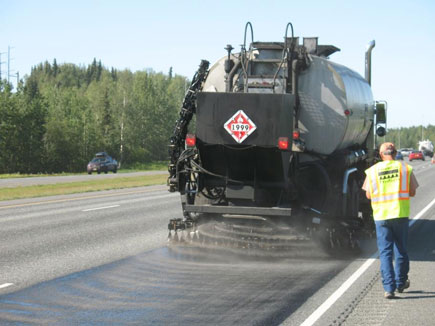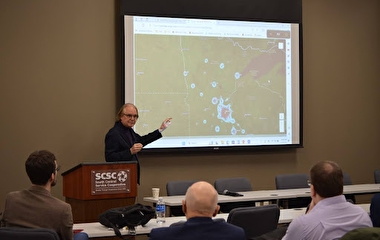In a recent project, the Alaska Department of Transportation (DOT) used a byproduct of Minnesota’s taconite mining industry for a section of the Alaska Glenn Highway.
The taconite byproduct—Mesabi sand—serves as the aggregate of a sand-seal treatment for a 4,600-foot stretch of the highway just north of Anchorage. Sand seals are an application of a sealer, usually an emulsion, immediately followed by a light covering of a fine aggregate (the sand).
“Our goal was to explore pavement preservation measures that extend pavement life and that also resist studded tire wear,” says Newton Bingham, central region materials engineer with the Alaska DOT. “Studded tires are allowed from mid-September until mid-April, and they cause rapid pavement wear.”
For the project, the Alaska DOT obtained sample pavement cores from the test area in 2014. Researchers then applied sand seals with two different hard aggregates—calcined bauxite and the Mesabi sand—to the surface of the cores to evaluate the effectiveness of each treatment.
Larry Zanko, senior research program manager of the Natural Resources Research Institute (NRRI) at the University of Minnesota Duluth, was the on-site representative for the taconite sand analysis. NRRI focuses on strategies to recover and utilize mineral-resource-based byproducts such as taconite and find potential beneficial end-uses for them.
“Taconite is one of the hardest natural aggregates,” he says. “Minnesota’s taconite mining industry generates tens of millions of tons of byproduct materials every year that could be used as pavement aggregate. Friction aggregates could be a higher-value niche for the industry.”
Testing of the sand-seals showed similar wear resistance for both types of aggregates. “We chose taconite sand since it is available from Minnesota as an industrial byproduct, whereas calcined bauxite sand has to be imported from nations on the Pacific Rim and costs more due to shipping,” Bingham says.
The Alaska DOT reports good performance to date on Glenn Highway and is funding ongoing pavement wear measurement.
NRRI researchers are also studying the use of taconite for other pavement applications. Funded by MnDOT, Zanko’s team developed (and later patented) a taconite compound for repairing pavement cracks and patching potholes (see September 2016 Catalyst). The long-lasting patches reduce maintenance costs and traffic disruption. In continuing work funded by the Minnesota Local Road Research Board, researchers will refine the repair compound and develop and field-test a low-cost mechanized system for pavement and pothole repairs.



